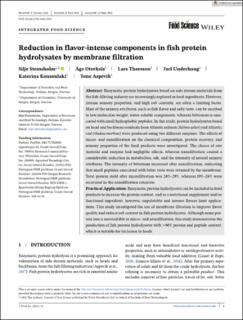| dc.contributor.author | Steinsholm, Silje | |
| dc.contributor.author | Oterhals, Åge | |
| dc.contributor.author | Thoresen, Lars | |
| dc.contributor.author | Underhaug, Jarl | |
| dc.contributor.author | Kousoulaki, Katerina | |
| dc.contributor.author | Aspevik, Tone | |
| dc.date.accessioned | 2021-08-26T06:39:55Z | |
| dc.date.available | 2021-08-26T06:39:55Z | |
| dc.date.created | 2021-08-25T09:29:24Z | |
| dc.date.issued | 2021 | |
| dc.identifier.issn | 0022-1147 | |
| dc.identifier.uri | https://hdl.handle.net/11250/2771289 | |
| dc.description.abstract | Enzymatic protein hydrolysates based on side stream materials from the fish-filleting industry are increasingly explored as food ingredients. However, intense sensory properties, and high salt contents, are often a limiting factor. Most of the sensory attributes, such as fish flavor and salty taste, can be ascribed to low-molecular-weight, water-soluble components, whereas bitterness is associated with small hydrophobic peptides. In this study, protein hydrolysates based on head and backbone residuals from Atlantic salmon (Salmo salar) and Atlantic cod (Gadus morhua) were produced using two different enzymes. The effects of micro- and nanofiltration on the chemical composition, protein recovery, and sensory properties of the final products were investigated. The choice of raw material and enzyme had negligible effects, whereas nanofiltration caused a considerable reduction in metabolites, ash, and the intensity of several sensory attributes. The intensity of bitterness increased after nanofiltration, indicating that small peptides associated with bitter taste were retained by the membrane. Total protein yield after microfiltration was 24%–29%, whereas 19%–24% were recovered in the nanofiltration retentate.
Practical Application
Enzymatic protein hydrolysates can be included in food products to increase the protein content, and as a nutritional supplement and/or functional ingredient; however, unpalatable and intense flavors limit applications. This study investigated the use of membrane filtration to improve flavor quality and reduce salt content in fish protein hydrolysates. Although some protein loss is unavoidable in micro- and nanofiltration, this study demonstrates the production of fish protein hydrolysates with >90% protein and peptide content, which is suitable for inclusion in foods. | en_US |
| dc.language.iso | eng | en_US |
| dc.publisher | Wiley | en_US |
| dc.rights | Attribution-NonCommercial-NoDerivatives 4.0 Internasjonal | * |
| dc.rights.uri | http://creativecommons.org/licenses/by-nc-nd/4.0/deed.no | * |
| dc.title | Reduction in flavor-intense components in fish protein hydrolysates by membrane filtration | en_US |
| dc.type | Journal article | en_US |
| dc.type | Peer reviewed | en_US |
| dc.description.version | publishedVersion | en_US |
| dc.rights.holder | Copyright 2021 The Authors | en_US |
| cristin.ispublished | true | |
| cristin.fulltext | original | |
| cristin.qualitycode | 1 | |
| dc.identifier.doi | 10.1111/1750-3841.15855 | |
| dc.identifier.cristin | 1928557 | |
| dc.source.journal | Journal of Food Science | en_US |
| dc.relation.project | Nofima AS: 11889 | en_US |
| dc.relation.project | Norges forskningsråd: 245883 | en_US |
| dc.relation.project | Norges forskningsråd: 226244 | en_US |
| dc.relation.project | EC/H2020/790956 BBI-JU | en_US |
| dc.relation.project | Sparebankstiftinga Sogn og Fjordane: 509-42/16 | en_US |
| dc.relation.project | Norges forskningsråd: 280498 | en_US |
| dc.identifier.citation | Journal of Food Science, 2021. | en_US |

